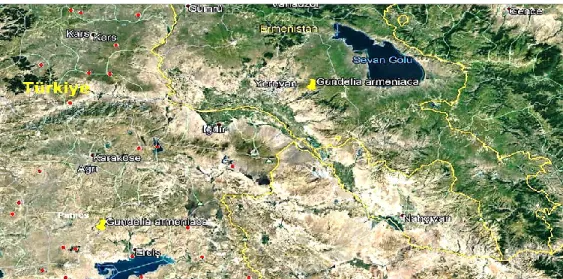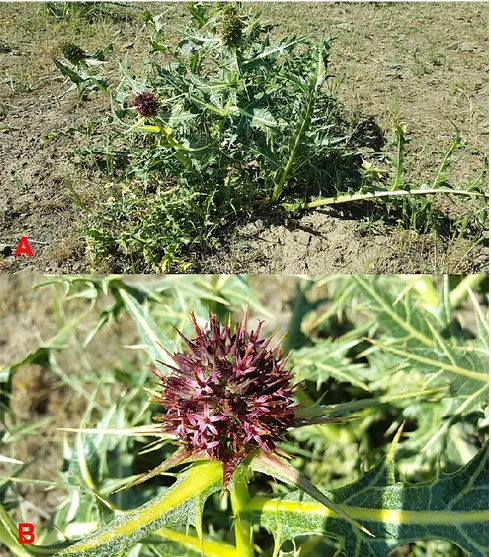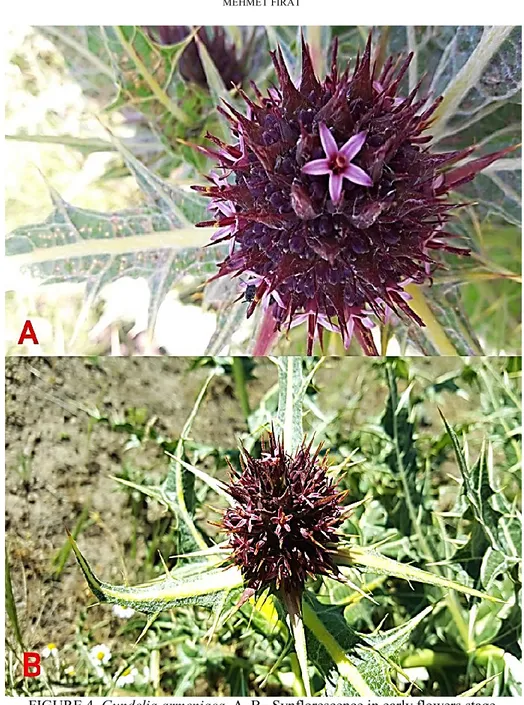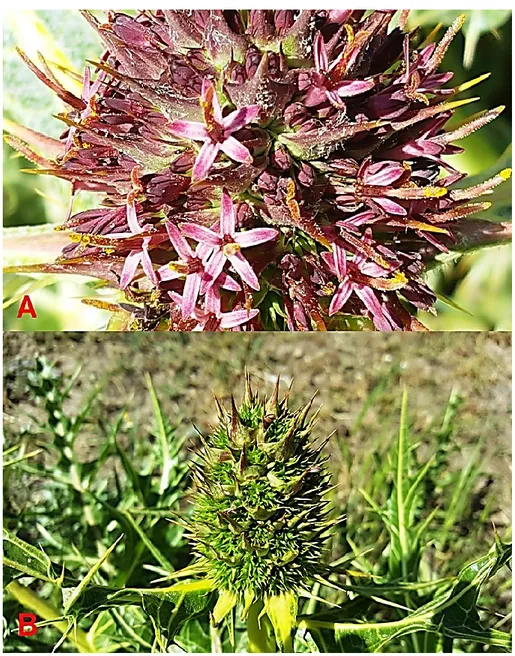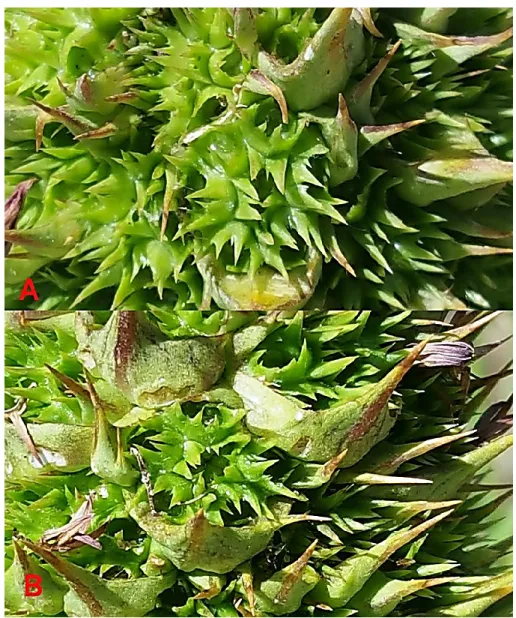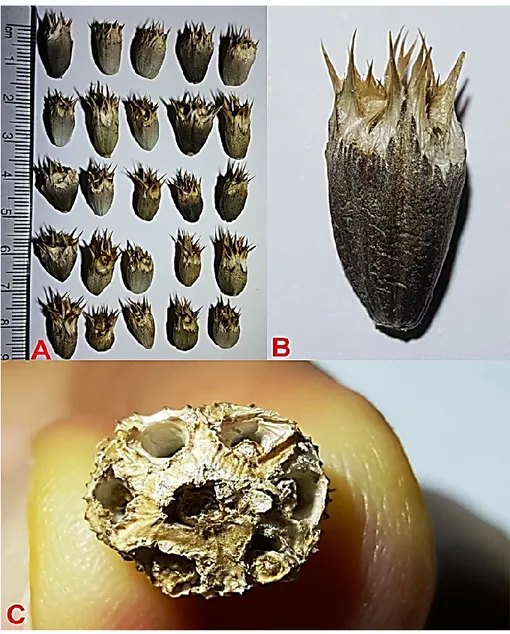Volume 27, Number 2, Pages 35-46 (2018) DOI: 10.1501/commuc_0000000196 ISSN 1303-6025 E-ISSN 2651-3749
http://communications.science.ankara.edu.tr/index.php?series=C
Received by the editors: September 06, 2018; Accepted: September 22, 2018. Key word and phrases: Asteraceae, Gundelia armeniaca, Ağrı, new record, Turkey
© 2018 Ankara University Communications Faculty of Sciences University of Ankara Series C: Biology
GUNDELIA ARMENIACA (ASTERACEAE); A SPECIES NEW TO THE
FLORA OF TURKEY, WITH CONTRIBUTIONS TO ITS TAXONOMY
MEHMET FIRAT
Abstract. Gundelia armeniaca Nersesian is recorded for the first time for the flora of Turkey. The specimens were collected from Patnos (Ağrı) province, eastern Anatolia. The species description, photographs and distribution map of the new record are presented.
1. Introduction
Gundelia L. belongs to the tribe Lactuceae according to the chloroplast ndhF gene [1]. In the different Flora accounts [2‒8] Gundelia tournefortii L. is the only known species of the genus Gundelia and all other names were recorded as synonyms. Recently, several new species have been described and new status proposed by different authors including Gundelia aragatsi Vitek, Fayvush, Tamanyan & Gemeinholzer, Gundelia armeniaca Nersesian from Armenia, and Gundelia dersim Vitek, Yüce & Ergin, Gundelia munzuriensis Vitek, Yüce & Ergin, Gundelia vitekii Armağan, Gundelia komagenensis Fırat,Gundelia colemerikensis Fırat, Gundelia mesopotamica Fırat and Gundelia asperrima (Trautv.) Fırat from Turkey, and Gundelia tehranica Vitek & Noroozi and Gundelia microcephala (Bornm.) Vitek from Iran.
Some important morphologic characters including plant size, number of flowers forming one cephaloid (=flower complex, heads of second order, pseudocephalia) in the synflorescence [11], size and shape of the fruit complex (disseminule), color of the flowers, indumentum in the synflorescence, indumentum of leaves, and habitats were used by Vitek et al. [9, 10] and Fırat [13] for separating species in the genus Gundelia. Besides, Nersesian [12] used the shape of the involucels of the central and lateral flowers as diagnostic characters. In addition, [13‒18] found some additional morphologic characters to help for distinguishing species in the genus as closure of flowers at ± noon and opening in ± late afternoon, the different/same colors of basal and cauline leaves and squamulose disseminule (beside glabrous disseminule).
During floristic surveys in Patnos (Ağrı) (Figure 1), from June to August 2015, 2016 and 2017, some interesting Gundelia specimens were collected. To determine those specimens, a wide range of literatures [e.g. 1‒28] were used and finally, they were identified as Gundelia armeniaca which was firstly described from Yerevan (Armenia).
2. Material and Methods
Photos of the living material were taken with a Sony DSCR1 digital camera. Accessions were georeferenced using a Magellan eXplorist 710 GPS. A total of 10 herbarium specimens of the species were collected from one adjacent localities and deposited in the herbaria VANF [25], and in the personal herbarium of the author (private Herbarium of Mehmet Fırat).
3. Results And Discusson
Taxonomy
Gundelia armeniaca Nersesian (Figures 2–7)
Type specimens: Абовянский район, окр. с. Гехадир, 10.06.1988, А. Нерсесян,
[Abovian region, surroundings of Geghadir village, 10.06.1988, A. Nersesyan] [holotype ERE 137773, isotypes ERE 137772, ERE 149115, ERE 149116, ERE 149117, W 2006- 0005938, W 2006-0005939].
CONTRIBUTIONS TO ITS TAXONOMY
Description: Perennial lactiferous herb with branched stem 30‒80 cm, glabrous or
more or less hairy. Leaves coriaceous, rigid, pinnatilobate, pinnatipartite or pinnatisected, spiny. Both side sparsely short or long ±arachnoid hairs, especially on or besides the veins. Synflorescences normally 3–15, globose or ovoid, 35‒80 mm long and 30‒50 mm in diameter (excluding bractes), consisting of 20–50 cephaloids. Synflorescence glabrous or less arachnoid hairy (when young more arachnoid hairs). Bracts spiny, normaly less exceeding cephaloids, with a strong terminal spine and 2‒5 lateral spines, green, purple or maroon, Cephaloid (in the middle of the synflorescence) compound of (5-)6‒7 flowers. Flowers campanulate to widely spreading, corolla externally reddish to dark pink or purple, dark purple (almost violet), ±with gland; internally various pink or reddish violet, 7‒9 mm long (usually central sorter than lateral). Cephaloids glabrous or rarely squamulose ±hairy. Fruit complex (disseminule) normally obconical, greyish-brown, 10–13 mm long (without spines), in upper part 6‒9 mm in diameter (when ripe); central and lateral flowers surrounded by spines originated from the involucels, spines of the central flowers 4–6 mm, of the lateral flowers 1–5 mm, obtained from 25 fruit of average weight 0.2061 g (when ripe).
Phenology: Flowering time from May to June and fruiting from July to August. Distribution: Gundelia armeniaca is new record from Patnos (Ağrı) province of
Turkey. According to the grid system (Davis 1965) the new species, falls specifically within the B9 square. It is growing type locality Yerevan (Armenia) and Ağrı (Turkey).
Habitat and ecology: Gundelia armeniaca grows in Astragalus sp. steppe, and
near lowland at c. 1600–1900 m. It is associate with other plants such as; Cirsium sp., Eryngium sp. Astragalus sp., Bromus sp., Poa sp. and Vicia sp.
Ethnobotanical usage: Gundelia armeniaca is known to be the tastiest and one of
the most consumed species. It is cooked as stew or egg-vegetable, obtained gum is chewed.
Vernacular name: Gundelia armeniaca is called as “Kereng” by the local people
of the Ağrı province. The other Gundelia species are known by the local people under many names in Kurdish; e.g. "Kênger", "Qorav", "Kereng", "Kerenk", "Keven", "Kengel", and in Turkish; e.g. "Has kanger", "Acı kenger", "Eşek dikeni", "Kenger" [27].
Red list assessment: The distribution area of: Gundelia armeniaca is less than
500,000 km2. The species was collected from two localities, and where it occurred,
ca. 10,000 individuals were counted. It is consumed by the local people and under pressure because of the some anthropogenic activities e.g. grazing. Based on the above data and observations, the IUCN [28] red list category of Gundelia armeniaca is suggested as “Vulnerable”, VU.
CONTRIBUTIONS TO ITS TAXONOMY
Other specimens examined: Gundelia armeniaca Turkey. B9 Ağrı, Patnos
district, 25 km from Ercis (Van) to Patnos, area of Astragalus sp. steppe, , 1881 m, 39°09′17″ N, 43°05′74″ E, coll. 11.06.2015, M. Fırat 32566 [(VANF, Herb. M. Fırat), (in flower)]; ibid. 15.08.2015, Fırat 32673 [(VANF, Herb. M. Fırat), (in fruit)].
CONTRIBUTIONS TO ITS TAXONOMY
FIGURE 5. Gundelia armeniaca. A‒ synflorescence in flowers stage, B‒ synflorescence in early fruiting stage.
FIGURE 6. Gundelia armeniaca. A- synflorescence seven fruiting early stage, B‒ synflorescence six fruiting early stage.
CONTRIBUTIONS TO ITS TAXONOMY
FIGURE 7. Gundelia armeniaca. A‒ variability of ripe disseminules, B‒ ripe disseminules, C‒ detail of cephaloid compound seven disseminules.
Comments: Flowers colour, flowers number and hair condition of Gundelia sp.
should be carefully observed and noted while it is fresh in the field. It is difficult to diagnose from dry material after it turns into a herbarium sample. Yerevan (Armenia) type sample of Gundelia armeniaca is taken from is a known place. And, only one species of Gundelia sp. grows. After my detailed researches on Gundelia species in recent years, taking the colour of corolla and number of cephaloid (in the middle of the synflorescence) compound of 6 flower groups into consideration. With the inclusion of the new record, total number of Gundelia species in Turkey increased to thirteen: Gundelia tournefortii, Gundelia armeniaca, Gundelia asperrima, Gundelia dersim, Gundelia munzuriensis, Gundelia vitekii, Gundelia komagenensis, Gundelia colemerikensis, Gundelia cilicica, Gundelia anatolica, Gundelia mesopotamica, Gundelia glabra and Gundelia rosea (Fırat 2016, 2017a, 2017b, 2017c). Based on the former studies and a new descibed species it is possible to claim that the genus deserves much attention on its taxonomy. According to my studies, with very high probability G. dersim is a variation of G. armeniaca.
Acknowledgements: I wish to thank Yüzüncü Yıl University BAP (Project
number: FDK-2017‒5179) for financial support.
References
[1] P.O. Karis, P. Eldenäs And M. Källersjö, New evidence for systematic
position of Gundelia L. With notes on delimitation of Arctoteae (Asteraceae). Taxon, 50, (2001) 105‒114.
[2] V.V. Nikitin, Gundelia L. In: B.K. Schischkin, (ed.) Flora Turkmenii 7.
Akademiia nauk Turkmenskoĭ SSR, Institut Botaniki, Ashkhabad (1960) 141.
[3] R.M. Sofieva, Gundelia L. In: I.I. Karjagin, (ed.) Flora Azerbajdžana 8.
Azerbaijan National Academy of Sciences Press, Baku (1961) 347–348.
[4] I.T. Vasilchenko, Gundelia L. In: V.L. Komarov (ed.) Flora SSSR 26. Nauka
Publishers, Moscow & Leningrad (1961) 862.
[5] F.K. Kupicha, Gundelia. In: P.H. Davis (ed.) Flora of Turkey and the East
Aegean Islands 5. University Press, Edinburgh (1975) 325–326.
[6] N. Feinbrun-Dothan, Flora Palaestina 3. The Israel Academy of Sciences
CONTRIBUTIONS TO ITS TAXONOMY
[7] K.H. Rechinger, Gundelia. In: K.H. Rechinger (ed.) Flora Iranica 164.
Akademische Druck- und Verlagsanstalt, Graz (1989) 107–109.
[8] V.E. Avetisian, Gundelieae. In: A.L. Takhtajan, (ed.) Flora Armenii
9,.Koeltz Scientific Books, Havlíčkův Brod, (1995) 212–216.
[9] E. Vitek, G. Fayvush, K. Tamanyan, And B. Gemeinholzer, New taxa of
Gundelia (Compositae) in Armenia. Annalen des Naturhistorischen Museums Wien, Serie B, 111, (2010), 85–99.
[10] E. Vitek, E. Yüce and C. Ergin, Gundelia dersim and Gundelia munzuriensis (Compositae), two new species from Turkey. Phytotaxa, 161, (2014) 130– 138.
[11] R. Classen-Bockhoff, H.A. Froebe, and D. Langerbeins, Die Infloreszenzstruktur von Gundelia tournefortii L. (Asteraceae). Flora, 182, (1989) 463–479.
[12] A. Nersesyan, Gundelia armeniaca Nersesyan (Compositae) a new species from Armenia. Annalen des Naturhistorischen Museums Wien, Serie B, 116, (2014) 191–196.
[13] M. Fırat, Four new species of Gundelia L. (Asteraceae) from Anatolia: G. komagenensis, G. colemerikensis, G. cilicica and G. anatolica, Vameda Ofset Press, Van, (2016) 32.
[14] M. Fırat, Gundelia rosea (Asteraceae), a new record for the Flora of Turkey with contributions to its systematics. Acta Biologica Turcica, 30(2), (2017a) 31‒35.
[15] M. Fırat, Gundelia mesopotamica (Asteraceae), a new lactiferous species from Mardin (Turkey). Acta Biologica Turcica, 30(3), (2017b) 64‒69. [16] M. Fırat, The resurection and a new status of Gundelia tournefortii L. var.
asperrima Trautv. (Asteraceae). OT Sistematik Botanik Dergisi, 24(2), (2017c) 57‒67.
[17] B. Tarikahya Hacıoğlu and M. Fırat, ITS Phylogeny and Molecular Dating of some Gundelia (Asteraceae) of Anatolia. Anadolu, 27(2), (2017) 74-77. [18] I. Genc and M. Fırat, Karyological study of the genus Gundelia
(Compositae) in Turkey. Caryology (2019) (In press).
[19] R.A. Al-Taey and M. Hossain, Studies in Gundelia: I. A new species from Iraq. Notes of the Royal Botanic Garden Edinburgh, 42, (1084) 39–44. [20] M. Armagan, Gundelia vitekii (Compositae), A new species from Turkey,
Annalen des Naturhistorischen Museums Wien, Serie B 118, (2016) 129– 134.
[21] E. Vitek and C.E. Jarvis, The typification of Gundelia tournefortii L. (Compositae). Annalen des Naturhistorischen Museum Wien, Serie B, 108, (2007) 267–272.
[22] E. Vitek and J. Noroozi, Gundelia tehranica (Compositae), a new species from Iran. Annalen des Naturhistorischen Museum Wien, Serie B, 119, (2017) 243–248.
[23] E. Vitek, and J. Noroozi, Gundelia rosea (Compositae), a new record from Iran. Annalen des Naturhistorischen Museum Wien, Serie B, 119, (2017) 249–256.
[24] E. Vitek, E. Yuce and U. Cakılcıoglu, Gundelia glabra Miller (Compositae) – an ignored taxon. Annalen des Naturhistorischen Museum Wien, Serie B, 119, (2017) 235–242.
[25] B. Thiers, (continuously updated): Index Herbariorum: A global directory of public herbaria and associated staff, New York Botanical Garden's Virtual Herbarium, Available from: http://sweetgum.nybg.org/ih/ (accessed 20 June 2017).
[26] E.R.A. Trautvetter, Plantarum messes anno 1974 in Armenia a Dre. G. Radde et in Daghestania ab A. Becker factas. Acta Horti Petropolitani, 4(1), (1876) 97–192.
[27] M. Fırat, Ferhenga Navên Riwekên, Dictionary of Plant Names in Kurdish, Kalkan Ofset, Ankara, (2013) 652.
[28] IUCN, Guidelines for Using the IUCN Red List Categories and Criteria, version 11. IUCN Species Survival Commission, Gland, Switzerland and Cambridge, (2014) 87.
Current Address: MEHMET FIRAT: Yüzüncü Yıl University, Faculty of Education, Department of Biology, TR-65080 Van, Turkey.
Email: kuyucak65@yahoo.com
